If you’re struggling to lose weight solely through diet and exercise, you’re not alone. In fact, the latest available data from
Statistics Canada indicates that
26.8% of the adult population is affected by excess weight[1]. If this resonates with you, weight loss medication may be an option worth exploring.
There are several prescription GLP-1 medications available in Canada to support healthy weight management, particularly for individuals with obesity or Type 2 diabetes. These medications can help regulate appetite, improve metabolic health, and support long-term weight loss when combined with lifestyle changes. However, it’s important to understand how these medications work, what potential risks are involved, and how to determine if you’re eligible.
This guide will walk you through how weight loss medications work, who they’re for, the potential risks, and how to speak with a healthcare provider about whether this approach is right for you.
Want to find out if you’re eligible for weight loss medication in Canada without leaving home?
Start your online assessment
to get connected with a licensed healthcare practitioner today.
How to Qualify for GLP-1 Medications in Canada
To qualify for GLP-1 medications, like Ozempic® in Canada, you need to be evaluated by a healthcare professional who will assess the following:
- Overall health
- Medical history
- Existing conditions
GLP-1 receptor agonists are designed to help adults regulate blood sugar levels and support sustainable weight loss. These medications are not suitable for everyone, and determining eligibility requires a thorough medical assessment.
Your healthcare practitioner will also review possible side effects and check for interactions with other medications you may be taking. This individualized assessment is essential, as GLP-1 therapies should only be prescribed when the potential benefits outweigh any risks. Always consult your healthcare provider before beginning this type of treatment.
Note: It’s recommended to ask your healthcare professional about any questions and/or concerns you may have so you can make an informed decision about this type of treatment.
Criteria for GLP-1 Medication
Eligibility for weight loss medications typically starts with
Body Mass Index (BMI).
Most prescriptions are recommended for individuals with a BMI of 30 or higher, or a BMI of 27 or higher if they have weight-related health conditions.
Beyond BMI, the decision should be personalized. Patients and healthcare providers should review current health conditions, medications, and family medical history. Cost and potential side effects are also important factors in determining whether a particular medication is right.
How Do You Get a Prescription for GLP-1 Weight Loss Medication in Canada?
To obtain a weight loss medication prescription in Canada, you’ll need to consult a licensed healthcare provider who will assess whether it’s suitable for you.
This can be done in person with your primary care provider or virtually through a Telehealth service like Rocky Health.
Here’s a breakdown of what this process is like with Rocky Health’s Telehealth service:
- Start with an Online Questionnaire.
You’ll answer questions about health history, current medications, weight-related goals, height, and weight, which helps calculate your
BMI and screen eligibility. - Pay a One-Time Initial Consultation Fee ($99).
After intake, you’ll pay a one-time fee and then meet virtually with a licensed healthcare provider via chat, phone, or video to review your profile and determine if GLP-1 medication is appropriate. - Undergo Personalized Lab Testing.
If you’re a suitable candidate, your clinician will provide a requisition for labs to assess metabolic health, hormones, and other indicators. - Receive a Prescription.
Based on your profile and lab results, your provider may prescribe the most suitable medication (such as Ozempic®, Mounjaro®, or Wegovy®) and personalize your plan. - Medication via Discreet Delivery.
Your medication is dispensed by Rocky’s certified pharmacy and typically arrives within 1–3 business days. - Ongoing Support & Follow-Ups.
Continued care via messaging or video check-ins with clinicians and pharmacist support. Dosage adjustments, refills, and guidance are managed in the secure portal.
Ready to explore whether weight loss medications are right for you?
Start your online assessment with a licensed healthcare practitioner
at Rocky Health today.
GLP-1 Weight Loss Medication Options in Canada
There are several GLP-1 medications approved for weight loss in Canada, including Wegovy® (semaglutide) and Saxenda (liraglutide). Other medications, such as Ozempic® and Mounjaro® are approved for Type 2 diabetes management, but not specifically for weight loss, although this is often an added benefit.
While some medications like Ozempic® are not officially approved for weight loss, they may be prescribed off-label by a healthcare professional in certain cases. Speak to your healthcare practitioner to determine if a GLP-1 medication is right for you.
Ozempic® (semaglutide)
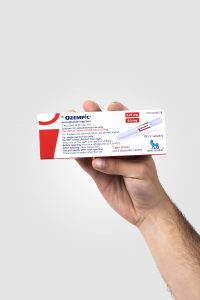
Originally approved for: Per
Health Canada, Type 2 diabetes to help manage blood sugar levels.
How it works: Mimics a natural hormone (GLP-1) to regulate blood sugar and reduce appetite. This often also leads to weight loss.
Typical use: Once-weekly subcutaneous (under the skin) injection into the abdomen, thigh, or upper arm.
Dosage: 0.2 mg or 0.5 mg to 1 mg, or 2 mg.
Weight loss benefit: Per weight loss studies, many patients lose 15% or more of their body weight[2].
Risks: Possible side effects include, but are not limited to, low blood sugar, vision changes, nausea, vomiting, diarrhea, stomach pain, and constipation[3].
Important Safety Information: Do not share your Ozempic® pen, even if the needle has been changed, as this can lead to serious infections.
Wegovy® (semaglutide)

Originally approved for: Chronic weight management for adults with obesity or overweight with weight-related comorbidities.
How it works: Mimics the effects of GLP-1, which helps regulate appetite, digestion, and blood sugar.
Typical use: Once-weekly subcutaneous injection.
Dosage: 0.25 mg with a gradual increase up to 1.7 mg or 2.4 mg.
Weight loss benefit: Average weight loss around 10% in clinical studies[4].
Risks: Side effects can include nausea, vomiting, diarrhea, constipation, and abdominal pain.
Important Safety Information: Do not share your pen.
Rybelsus® (oral semaglutide)
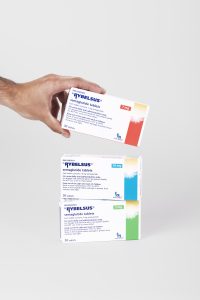
Originally approved for: Per
Health Canada, Type 2 diabetes in adults, alongside diet and exercise.
How it works: Oral semaglutide that mimics GLP-1 to regulate blood sugar and reduce appetite.
Typical use: Daily oral tablet taken in the morning on an empty stomach.
Dosage: 3 mg, 7 mg, or 14 mg.
Weight loss benefit: Produces modest weight loss compared with injectable forms[5]. Possible side effects include nausea, abdominal pain, diarrhea, and decreased appetite.
Mounjaro® (tirzepatide)
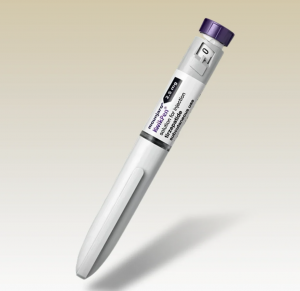
Originally approved for: Per
Health Canada, for adults with Type 2 diabetes mellitus to improve glycemic control.
How it works: Dual GIP and GLP-1 receptor agonist that increases insulin release and lowers glucagon, helping control post-meal sugar spikes and appetite.
Typical use: Once-weekly subcutaneous injection.
Dosage: Starts at 2.5 mg, may increase gradually up to 15 mg.
Weight loss benefit: Clinical trials show higher weight loss than many GLP-1s, with some patients losing over 20% of body weight[6]. Common side effects include nausea, vomiting, diarrhea, decreased appetite, and injection site reactions.
Important Safety Information: Do not share your pen.
Zepbound® (tirzepatide)
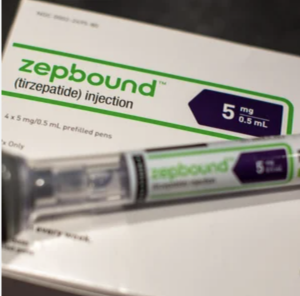
Originally approved for: In Canada, for adults who are obese or overweight with at least one weight-related comorbidity.
How it works: Dual GIP and GLP-1 receptor agonist that increases insulin release and reduces glucagon, helping control blood sugar and appetite.
Typical use: Once-weekly subcutaneous injection.
Dosage: 2.5 mg, 5 mg, 7.5 mg, 10 mg, 12.5 mg, and 15 mg.
Weight loss benefit: In clinical trials, patients lost an average of ~20% at the highest dose. Common side effects include nausea, vomiting, diarrhea, decreased appetite, and injection site reactions. Not recommended for end-stage renal impairment.
Saxenda™ (liraglutide)
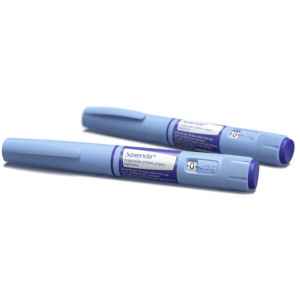
Originally approved for: Adults with obesity or overweight and at least one weight-related condition.
How it works: GLP-1 receptor agonist that slows gastric emptying, increases satiety, and helps control appetite.
Dosage: Once-daily subcutaneous injection; typically titrated up to 3 mg.
Weight loss benefit: Clinical trials show an average 5–10% weight loss over 1 year. Side effects may include nausea, vomiting, diarrhea, constipation, and headache; risks include pancreatitis and gallbladder disease. Not recommended for those with a personal/family history of MTC or MEN2.
| Medication | Drug Type | Administration | Dosage range | Approved Use (Canada) | Weight Loss Benefits | Common Side Effects |
|---|---|---|---|---|---|---|
| Ozempic® (semaglutide) | GLP-1 receptor agonist | Once-weekly injection | 0.2 mg or 0.5 mg to 1 mg, or 2 mg | Type 2 diabetes | ~15% average | Nausea, vomiting, diarrhea, abdominal pain, low blood sugar |
| Mounjaro® / Zepbound® (tirzepatide) | Dual GIP & GLP-1 agonist | Once-weekly injection | 2.5 mg up to 15 mg | Type 2 diabetes; weight management | Up to ~20% in trials | Nausea, vomiting, diarrhea, injection site reactions |
| Wegovy® (semaglutide) | GLP-1 receptor agonist | Once-weekly injection | Up to 2.4 mg | Chronic weight management | ~10% average | Nausea, vomiting, diarrhea, constipation, abdominal pain |
| Rybelsus® (oral semaglutide) | GLP-1 receptor agonist | Daily oral tablet | 3 mg, 7 mg, 14 mg | Type 2 diabetes | Modest | Nausea, abdominal pain, diarrhea, decreased appetite |
| Saxenda™ (liraglutide) | GLP-1 receptor agonist | Once-daily injection | Up to 3 mg | Chronic weight management | 5–10% average | Nausea, vomiting, diarrhea, constipation, headache; pancreatitis/gallbladder risk |
If you’re considering GLP-1 medications for weight management,
consult with a healthcare provider
to determine the most appropriate treatment based on your individual health profile and needs.
Resources
“Management and Impact of Obesity in Canada: A Real-World Survey.”
System, Elsevier, 2025. Accessed 16 Aug. 2025.- Bergmann, N. C., et al.
“Semaglutide for the Treatment of Overweight and Obesity: A Review.”
Diabetes, Obesity and Metabolism, vol. 25, no. 1, Jan. 2023, pp. 18–35.
“Ozempic® (semaglutide) Injection: What Is Ozempic®?”
Novo Nordisk. Accessed 16 Aug. 2025.- Ryan, Donna H., et al.
“Long-Term Weight-Loss Effects of Semaglutide in Obesity without Diabetes in the SELECT Trial.”
Nature Medicine, 2024, pp. 2049–2057. - Novo Nordisk.
RYBELSUS® Results. 2025. Accessed 16 Aug. 2025. - Allan, G. Michael, and Ricky D. Turgeon.
Mission Slimpossible, Part 3: Tirzepatide for Weight Loss (Tools for Practice no. 392)
. CFPCLearn, 24 June 2025. Accessed 16 Aug. 2025.
Disclaimer: This article is intended for informational purposes only and is not a substitute for professional medical advice, diagnosis, or treatment.
Always consult your healthcare provider with any questions about a medical condition or treatment, including dosage, risks, benefits, and other considerations.
Editorial Standards: At Rocky Health, we’ve made it our mission to support men and women by creating trustworthy, easy-to-understand medical and health information online.
The content we create is crafted by skilled writers and reviewed by licensed medical professionals and healthcare experts.
Read more about our editorial standards here.



